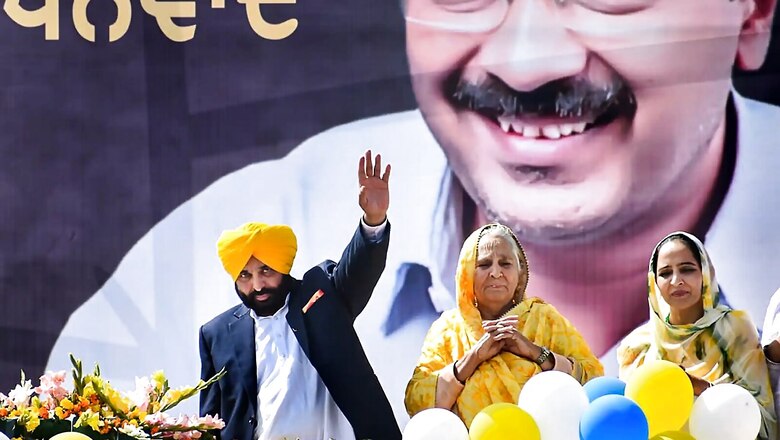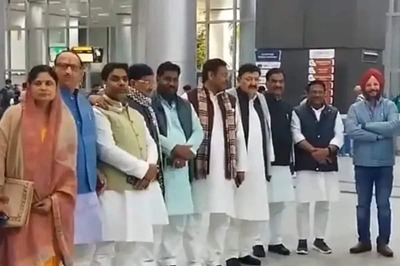
views
“Punjab mein shiksha ki rajneeti jeetegi,” Deputy chief minister of Delhi Manish Sisodia told me in a conversation on March 8. The Delhi government, he said, is now known for its work on education, health and economic growth. “The people of Punjab expect it from us,” he said, adding that voters often say to them that parties talk to them about education but when they form governments, ‘they make us fight on the basis of religion and caste’.
That was two days before the Aam Aadmi Party (AAP) won Punjab. Indeed, its chief minister-designate Bhagwant Mann announced after winning that his first order of business after taking office would be schools, health, industry, making agriculture profitable, ensuring safety of women and improving sports infrastructure.
Founded in 2012, the AAP has already won Delhi, where it has been in power for seven years, and now it will have a chance to govern one of the country’s most prominent states. In start-up terms — the perfect comparison given Arvind Kejriwal is a graduate of IIT Kharagpur — it is a political unicorn. Of its rivals, the BJP was formed in 1980 but is backed by the organisational force of the Rashtriya Swayamsevak Sangh (RSS), founded 96 years ago. The Congress, its other rival, is even older, founded 136 years ago. Veteran scholar and retired professor from the Jawaharlal Nehru University, Chaman Lal, calls it the first and so far the only political party in India of the Internet age with none of the baggage from the freedom movement whether of Jawaharlal Nehru for the Congress or Veer Savarkar in case of the BJP.
So what makes AAP unique? It’s what made Punjab give it another chance after the 2017 Assembly elections where it won a mere 20 of the 117 seats, falling well short of the tally predicted by exit polls. It was a combination of their work in Delhi; their iconography (Bhagat Singh to appeal to a cross-section of the youth and B.R. Ambedkar to attract Dalits); the anger among farmers over the three farm laws, repealed later; and their consistent promotion through social media and on-ground social volunteers.
ALSO READ | Mandate 2022 Shows Yogi is King in the North and AAP is the Harbinger of Hope
Unlike in 2017, they promoted former MP Bhagwant Mann rather than AAP founder Arvind Kejriwal. The party’s slogan, Ik mauka Kejriwal nu, became Hun nhi khavange dhokha, Kejriwal te Bhagwant Mann nu devange mauka. All attempts to undermine Mann with videos of his drunken behaviour backfired in Punjab with comments such as kaun nahin peeta (who doesn’t drink?). Mann himself very cleverly played on the emotions attached to Bhagat Singh and Ambedkar, even vowing to take oath as chief minister in Khatkar Kalan in Nawanshahr tehsil, Bhagat Singh’s ancestral village. He also said no government office would carry pictures of the chief minister, instead there would be pictures of Bhagat Singh and B.R. Ambedkar. He stuck to projecting a family man image, getting his mother and sister to campaign for him, as well as Kejriwal’s wife and daughter. Does Punjab see in the popular comic their own comedian-turned-Ukrainian President Volodymyr Zelensky? The AAP certainly wanted to portray him as the underdog, using the popular Punjabi song, R. Nait’s Dabda Kithe Aa, suggesting that he is resilient and won’t accept defeat.
Documentary filmmaker Daljit Ami says it is more about repulsion than attraction. “It is the cumulative expression of frustration, disillusionment with traditional parties, attraction of distantly tested new option and the rebellious character of youth which benefits AAP in Punjab. The first generation aspirational class of politicians and grassroot activists finds the AAP a better option compared to other parties with extremely limited chances for mobility,” he adds.
What does this mean for the party’s eventual ideological direction. Will it move towards the centre-right, like the Congress is doing, in the direction of the BJP, or centre-left, like the Congress used to be, and for which there is space in the political spectrum. Lal believes the AAP has an opportunity to be a truly centrist party. It is invoking the atheist Bhagat Singh despite running a populist programme in Delhi, the Mukhyamantri Tirth Yatra Yojana, under which the Delhi government bears the expenditure of the entire pilgrimage of senior citizens to 13 holy circuits. “There is a contradiction,” points out Chaman Lal, “in the two slogans it has been using since it was founded, one to appeal to the left oriented, Inquilab Zindabad, and the other to the Hindu-minded, Bharat Mata ki Jai. They added Ambedkar later from their ground experience.”
Jasdeep Singh, a scriptwriter, believes the promise of fixing the broken government schools and hospitals of Punjab has worked like magic. “The youth see it as a shift from the established order of the Congress and the Akali Dal, which have been swept away. A new relatively cleaner and more approachable system of governance has been put in place,” he says. Ashutosh, the well-known journalist formerly with the AAP, says youngsters fatigued with traditional politics are just looking for an alternative.
Kejriwal has described the election as a revolution. One can only hope it doesn’t devour its children.
The author is a senior journalist and former editor of India Today magazine. The views expressed in this article are those of the author and do not represent the stand of this publication.
Read all the Latest Opinion News and Breaking News here




















Comments
0 comment